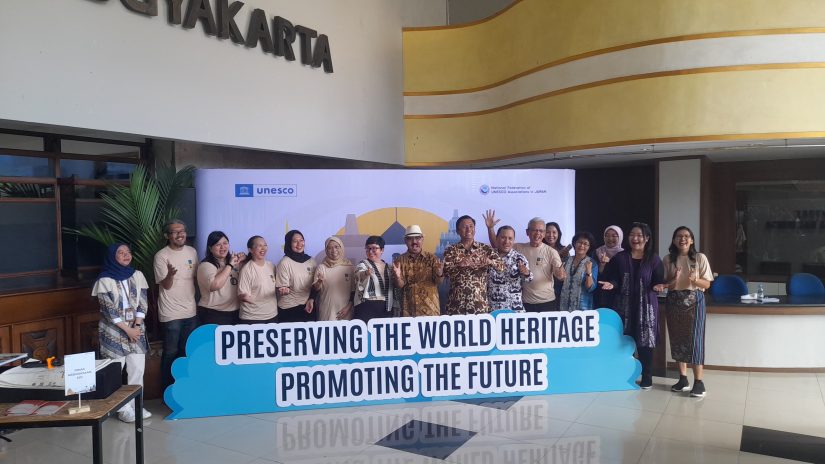
On Thursday, April 18, 2024, Faculty of Cultural Sciences UGM participated in a series of UNESCO Jakarta events together with Tidar University and Atma Jaya University Yogyakarta to commemorate World Heritage Day 2024. UGM Archaeology students joined the one-day event held at Campus II of Atma Jaya University Yogyakarta. This activity is an effort from UNESCO to raise public awareness, especially among young people or students, on the diversity of cultural heritage and draw people’s attention to the vulnerability of existing cultural heritage and steps to protect it. This activity also demonstrates collaboration for the management of cultural heritage sites that include aspects of conservation and interaction with heritage preservation communities for sustainable development.
The event began with an opening in the lobby of the Campus II building of Atma Jaya University Yogyakarta with an exhibition consisting of local crafts. The local works were inspired by Indonesia’s cultural heritage, such as leather wallets in the shape of Borobudur, typical Borobudur wedang powder, card games about cultural heritage conservation, miniature Prambanan temples, and others. The opening began with a group photo followed by representatives from UNESCO Jakarta, UGM, Tidar University, Atma Jaya University Yogyakarta, and Borobudur Conservation Center. The event then proceeded to the Campus II Auditorium for the opening by the representatives and a special opening by the Head of Culture Unit UNESCO Jakarta, Moe Chiba followed by a representative from Borobudur Conservation Center, Mr. Brahmantara. Followed by a panelist session by two main speakers.
The first and second main speakers, Mr. Brahmantara from Borobudur Conservation Center and Ms. Dian Nisa Anna Rahmayani, from Sangiran Conservation Center gave a panel presentation session entitled, “World Heritage Management, Community Engagement and Current Challenges”. This panel presentation presented how a cultural heritage site is managed and the interaction of the management institution to the community with current challenges. Cases used as examples were the management of Borobudur, Sangiran, and the presentation of various cultural heritage site mapping techniques.
The students of the three universities attended the event by sitting in groups and enlivened the event by voicing yells from each group and participating in two game sessions at the interval. Both games were in the form of cultural heritage site puzzles that emphasized the role of group cooperation to solve the puzzles together. Students were given 15 minutes to complete the puzzle. The winners of the puzzles were then awarded prizes after the event ended.
The commemoration of World Heritage Day held by UNESCO Jakarta supported by the National Federation of UNESCO Associations in Japan (NFUAJ) had an important impact on the community, especially on students. The introduction of local culture and crafts as well as the exposure of how to manage a cultural or world heritage site is the essence of building collective awareness. Awareness to maintain and preserve cultural heritage that becomes regional and national identity.

